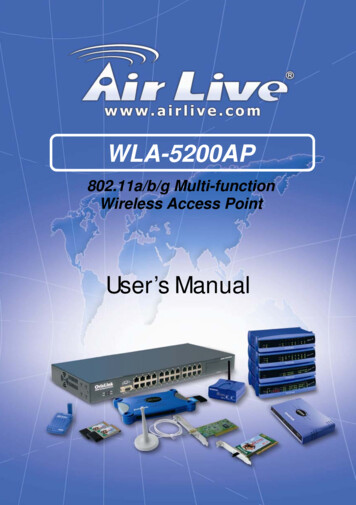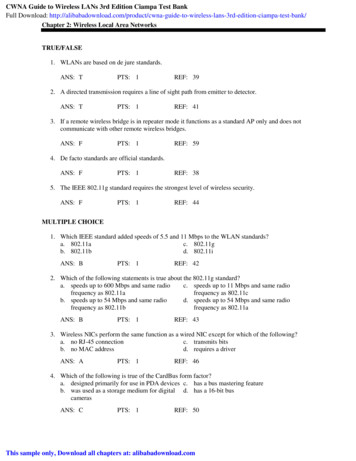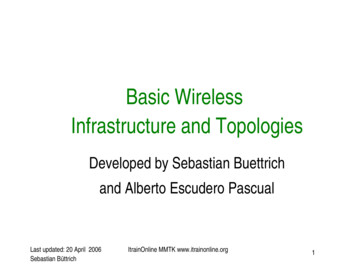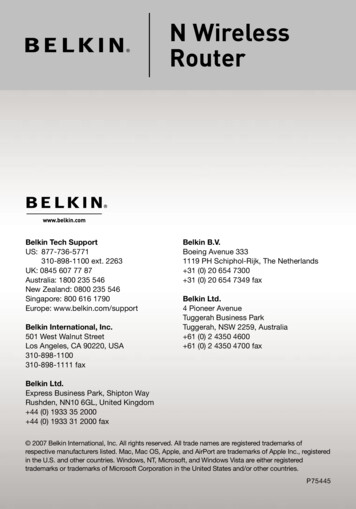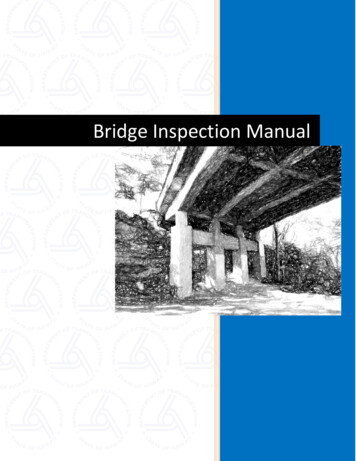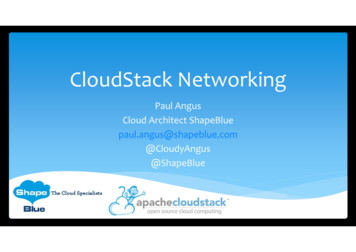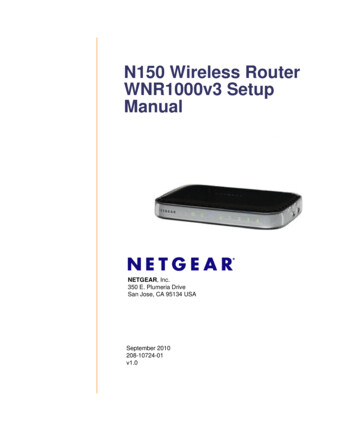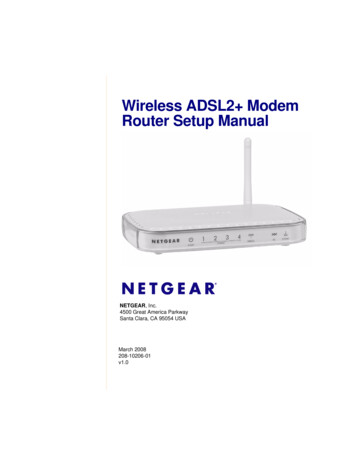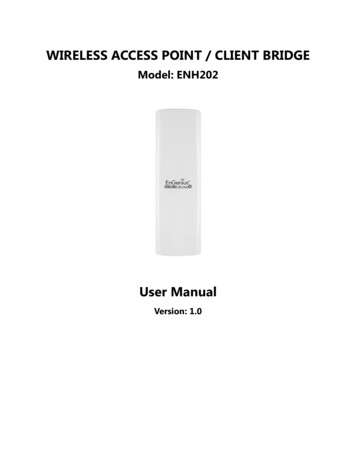
Transcription
WIRELESS ACCESS POINT / CLIENT BRIDGEModel: ENH202User ManualVersion: 1.0
Table of Contents1 PRODUCT OVERVIEW . 61.1 FEATURES. 61.2 BENEFITS . 81.3 PACKAGE CONTENTS . 91.4 SYSTEM REQUIREMENT. 91.5 HARDWARE OVERVIEW . 91.6 UNDERSTANDING THE ENH202 LEDS . 102 INSTALLATION.112.1 PRE-INSTALLATION GUIDELINES .112.2 INSTALLING THE ENH202 .113 WIRELESS NETWORK MODES . 123.1 ACCESS POINT MODE . 123.2 ACCESS POINT WITH WDS FUNCTION MODE. 133.3 CLIENT BRIDGE MODE . 143.4 WDS BRIDGE MODE . 153.5 CLIENT ROUTER MODE . 164 CONFIGURING YOUR COMPUTER FOR TCP/IP. 184.1 CONFIGURING MICROSOFT WINDOWS 7. 184.2 CONFIGURING MICROSOFT WINDOWS VISTA . 204.3 CONFIGURING MICROSOFT WINDOWS XP . 214.4 CONFIGURING APPLE MAC OS X . 224.5 LOGGING INTO THE ENH202. 235 STATUS. 255.1 SAVE / LOAD. 255.2 MAIN . 265.3 WIRELESS CLIENT LIST . 275.4 SYSTEM LOG . 275.5 CONNECTION STATUS . 285.6 DHCP CLIENT TABLE . 286 SYSTEM. 296.1 SWITCHING THE OPERATION MODE . 297 WIRELESS CONFIGURATION . 307.1 WIRELESS SETTINGS . 307.1.1 Access Point Mode . 307.1.2 Client Bridge Mode . 33
7.1.3 WDS Bridge Mode. 357.1.4 Client Router Mode . 377.2 WIRELESS SECURITY SETTINGS . 397.2.1 WEP. 397.2.2 WPA-PSK. 407.2.3 WPA2-PSK. 417.2.4 WPA-PSK Mixed . 427.2.5 WPA . 437.2.6 WPA2 . 447.2.7 WPA Mixed. 457.3 WIRELESS ADVANCED SETTINGS . 467.4 WIRELESS MAC FILTER . 487.5 WDS LINK SETTINGS . 498 LAN SETUP. 508.1 IP SETTINGS . 508.2 SPANNING TREE SETTINGS . 519 ROUTER SETTINGS . 529.1 WAN SETTINGS. 529.1.1 Static IP . 529.1.2 DHCP (Dynamic IP) . 549.1.3 PPPoE (Point-to-Point Protocol over Ethernet) . 569.1.4 PPTP (Point-to-Point Tunneling Protocol) . 589.2 LAN SETTINGS (ROUTER MODE). 609.3 VPN PASS THROUGH. 619.4 PORT FORWARDING . 629.5 DMZ . 6310 MANAGEMENT SETTINGS . 6410.1 ADMINISTRATION . 6410.2 MANAGEMENT VLAN . 6510.3 SNMP SETTINGS. 6610.4 BACKUP/RESTORE SETTINGS . 6710.5 FIRMWARE UPGRADE . 6710.6 TIME SETTINGS . 6810.7 LOG . 6910.8 DIAGNOSTICS . 7011 NETWORK CONFIGURATION EXAMPLES. 7111.1 ACCESS POINT . 7111.2 CLIENT BRIDGE MODE . 7211.3 WDS BRIDGE MODE . 73
11.4 CLIENT ROUTER MODE . 74APPENDIX A – TROUBLESHOOTING . 75A.1 PROBLEM SOLVING . 75A.2 CONTACTING TECHNICAL SUPPORT . 76APPENDIX B – SPECIFICATIONS . 77APPENDIX C – GLOSSARY . 78APPENDIX D – STATEMENTS OF CONFORMITY. 84D.1 – FEDERAL COMMUNICATION COMMISSION INTERFERENCE STATEMENT . 84D.2 – INDUSTRY CANADA STATEMENT . 85D.3 – EUROPE DECLARATION OF CONFORMITY . 86
About This DocumentThis document is written by EnGenius Inc. EnGenius Inc. the reserves the right to change thisdocument without notice and all rights are reserved. This document can only be used for theconfiguration of EnGenius products.This document is to characterize the EnGenius ENH202 Wireless Access Point & ClientBridge. Please read the document carefully before setting up the ENH202. Any damage whichis caused by inappropriate use will not be covered under the warranty.FormatsThis document uses following symbols to indicate and highlight special messages.Caution: This symbol represents a vital message and it is critical for the deviceor settings.Note: This symbol represents an important message for the settings.Tip: This symbol represents an alternative choice that can save time orresources.Before you startThe following equipment is required to setup the ENH202:1. (1) Computer/Notebook and Internet access.2. (2) Ethernet cables.3. (1) EnGenius ENH202.The equipment listed above is only for configuration of the ENH202, you willneed additional equipment to connect to the Internet and configuration will depend on yourcurrent network infrastructure. Please refer to Chapter 2 for more information.
1 Product OverviewThank you for using the ENH202. It is a powerful and enhanced business-class product with 4multi-functions: Access Point, Client Bridge, WDS, and Client Router.EnGenius’ ENH202 uses the latest wireless standard, 802.11n, which allows for faster wirelessthroughput. The ENH202 affords a great advantage to minimize the time and cost which isrequired to expand your network. It operates at 2.4GHz and is also backwards compatible with802.11a networking equipment.The ENH202 is easy to install almost anywhere with included proprietary Power over Ethernetadapter for quick outdoor installation. In addition, the ENH202 can manage power levelcontrol, and it features narrow bandwidth selection, traffic shaping and real-time RSSIindication. The ENH202 fully supports wireless encryption including Wi-Fi Protected Access(WPA-PSK/WPA2-PSK), (64/128/152)-bit WEP Encryption, and IEEE 802.1x with RADIUS.Additionally, the ENH202 is an ideal choice to pair with the ENH202 in a Access Point – ClientBridge or WDS Bridge – WDS Bridge topology.The ENH202 utilizes a proprietary PoE adapter. Only use the supplied PoEadapter. Damage may occur if another PoE adapter is used.1.1 FeaturesThe following list describes the design and scope of the ENH202 made possible through thepower and flexibility of wireless LANs:a) Difficult-to-wire environmentsThere are many situations where wires cannot be laid easily. For example, historicand older buildings as well as open areas and cross-street architectures make theinstallation of LANs either impossible or very expensive.b) Temporary workgroupsConsider situations in parks, athletic arenas, exhibition centers, disaster-recovery,temporary offices and construction sites where one wants a temporary WLANestablished and removed at a future date. The ENH202 is easy to place into andremove from production.c) The ability to access real-time informationDoctors and nurses, point-of-sale employees, and warehouse workers can accessreal-time information while dealing with patients, serving customers, andprocessing information.
d) Frequently altered environmentsShow rooms, meeting rooms, retail stores, and manufacturing sites are primeexamples where frequently rearranged workplaces are suited for wireless LANs.e) Wireless extensions of Ethernet networksNetwork managers in dynamic environments can minimize the overhead caused bymoves, extensions to networks, and other changes by utilizing wireless LANs.f) Wired LAN backupNetwork managers may implement wireless LANs to provide redundancy formission-critical applications which are implemented on wired networks.g) Training and educational facilitiesTraining sites at corporations and students at universities use wireless connectivityto afford access to information, information exchanges, and learning.FeaturesHigh Speed Data RateUp to 300 MbpsHigh Output Power upto 29 dBmIEEE 802.11a/nCompliantMulti-FunctionSupport RSSIIndicator (CB mode)Power-over-EthernetSupport Multi-SSIDfunction (4 SSID) inAP modeWPA2/WPA/ WEP/IEEE 802.1x supportMAC address filteringin AP modePPPoE/PPTP functionsupport (APRouter/CR mode)SNMP RemoteConfigurationManagementQoS (WMM) supportCapable of handling heavy data payloads such as HD videostreamingExtended range and excellent coverageFully interoperable with IEEE 802.11 a/n compliant devicesUsers can use different modes in various environmentsUsers can select the best signal to connect with AP efficientlyFlexible Access Point locations and cost savings (Note: TheENH202 includes a proprietary PoE adapter.)Allow clients to access different networks through a singleaccess point and assign different policies and functions for eachSSIDFull support for all types of current wireless security standardsEnsure secure network by enforcing network access control listsEasy to access Internet via ISP service authenticationAllow administrators to remotely configure or manage theAccess Point.Enhance user performance and density
1.2 BenefitsAccess Point ModeUse this feature to setup the access point’s configurationinformation. It supports transmit power and channel adjustments.Clients can access the network with different regulatory settingsand automatically change to the local regulations.Client Bridge ModeUse this feature to connect to an Access Point, enabling WANsharing.WDS ModeUse this feature to link multiple APs in a network; All associatedclients from any AP can communicate with each other like inad-hoc mode.Client Router ModeClients connect wirelessly to an AP and transmit data through APto access the Internet.Multiple SSIDsENH202 supports up to 4 SSIDs on your access point. Thefollowing options can be set to each SSID:-Public or private SSIDAuthenticationVLAN identifierRADIUS accounting identifier-Profile isolation for infrastructure networkVLANSpecify a VLAN number for each SSID to separate the servicesamong clients.QoSUse this feature to limit the incoming or outgoing throughput.Wi-Fi Protected Access Wi-Fi Protect Access is a standard-based interoperable securityenhancement that increases the level of data protection andaccess control for existing and future wireless LAN systems. It iscompatible with IEEE 802.11i standard. WPA leverages TKIP and802.1X for authenticated key management.
1.3 Package ContentsOpen the package carefully, and make sure that none of the items listed below are missing.Do not discard the packing materials; in case of return, the unit must be shipped in its originalpackaging. (1) Wireless Access Point / Client Bridge (ENH202) (1) 24V/1.0A Power Adapter (1) PoE Injector (EPE-24R) (1) Mounting Kit with Mast-Mount Strap Special Screw Set (1) QIG (1) CD (User Manual)Using a power adapter other than the one included with the ENH202 maycause damage to the device.1.4 System RequirementThe following conditions are the minimum system requirements. A computer with an Ethernet interface and operating under Windows XP, Vista, 7 orLinux. An Internet browser that supports HTTP and JavaScript.1.5 Hardware OverviewPhysical Interface- 1 x 10/100 LAN Port with PoE support- 1 x 10/100 LAN port- 1 x Reset buttonMaximum Wireless Data rate- 300 MbpsLEDs status- Power Status- LAN (10/100Mbps)- WLAN (Wireless is enabled)- 3 x Link Quality (Client Bridge mode)
1.6 Understanding the ENH202 LEDsThe rear of the ENH202 has two groups of LEDs. One group, labeled INDICATORS, shows thestatus of the device. The second group, LINK QUALITY, shows the strength of the linkbetween the ENH202 and the network. The following table describes the ENH202 LEDs.LEDColorModeStatusPowerGreenOFF ENH202 is not receiving power.ON ENH202 is receiving power.LANGreenOFF ENH202 is not connected to the network.ON ENH202 is connected to the network, but not sending orreceiving data.Blink ENH202 is sending or receiving data.WLANGreenAccess PointOFF ENH202 radio is off and the device is notor Clientsending or receiving data over the wireless LAN.BridgeON ENH202 radio is on, and the device is notModesending or receiving data over the wireless LAN.Blink ENH202 radio is on, and the device issending or receiving data over the wireless LAN.Link QualitySee Status columnAccess PointShows the strength of the link between theor ClientENH202 and the network.BridgeG good quality (green).ModeY medium quality (yellow).R poor or no link (red).
2 InstallationThis chapter describes how to install the ENH202.Only experienced installation professionals who are familiar with local building andsafety codes and, wherever applicable, are licensed by the appropriate government regulatoryauthorities should install the ENH202.2.1 Pre-installation GuidelinesSelect the optimal locations for the equipment using the following guidelines:-The ENH202 should be mounted on a 1"- 4" pole. Its location should enable easy accessto the unit and its connectors for installation and testing.The higher the placement of the antenna, the better the achievable link quality.The antenna should be installed to provide a direct or near line of sight link with the basestation antenna. The antenna should be aligned to face the general direction of the basestation.2.2 Installing the ENH202To install the ENH202, use the following procedure to mount the device on a pole and refer tothe figure below.1.The bottom of the ENH202 is a removable cover. Grab the cover and push downslightly while pulling it backward to remove the cover.2.Insert a standard Ethernet cable into the RJ-45 port labeled MAIN LAN.3.Slide the cover back to seal the bottom of the ENH202.4.Remove the power cord and PoE injector from the box and plug the power cordinto the DC port of the PoE injector.Only use the power adapter supplied with the ENH202. Using a different poweradapter might damage the ENH202.5.Plug the other side of the Ethernet cable in Step 3 into the PoE port of the PoEinjector. When you finish Step 5, the installation will resemble the following picture.
6.Turn over the ENH202. Then insert the mast strap through the middle hole of theENH202. Use a screwdriver to unlock the pole-mounting ring putting it through theENH202.7.Mount the ENH202 securely to the pole by locking the strap tightly.This completes the installation procedure.3 Wireless Network Modes3.1 Access Point ModeIn the Access Point Mode, the ENH202 functions like a central connection for any stations or
clients that support the IEEE 802.11a/n standards. Stations and clients must utilize the sameSSID and Security Password to associate while within range. The most suitable topology forthis mode is to have one ENH202 as an AP and the second one as a Client-Bridge – whennecessary a third Client-Bridge can be place within the directional antenna’s path. Oneadvantage of using the ENH202 to create point-to-point outdoor wireless links is when theenvironment is prone to radio interference on 2.4GHz band. Running the network on 2.4GHzcan avoid the interference, thus providing higher stability to the network.3.2 Access Point with WDS Function ModeThe ENH202 also supports WDS functionality while in Access Point Mode. Simply configureother Access Points and the associated MAC addresses in order to enlarge the wireless area byenabling WDS Link Settings. WDS functionality can support up to 8 different AP MACaddresses. Please note that this mode is rarely used due to the nature of directional antennae.Consequently, the wireless clients need to be located in the path of the ENH202’s directionalantenna and be within in the range to send signal back to the ENH202.
Not every Access Point supports WDS in Access Point Mode. It isrecommended to use ENH202 if you would like to utilize this functionality.3.3 Client Bridge ModeIn the Client Bridge Mode, the ENH202 functions like a wireless client, connecting to anAccess Point wirelessly and enabling Internet connectivity wherever you want. Use Site Surveyfunction to scan all of the Access Points within range and configure the SSID and SecurityPassword to associate with it. With Client Bridge Mode, the ENH202 works as long range2.4GHz wireless-Ethernet Bridge in order to provide a 2.4GHz link between the access pointand networked clients.
3.4 WDS Bridge ModeIn the WDS Bridge Mode, the ENH202 can wirelessly connect different local area networks byconfiguring each device’s MAC address and security settings. The WDS Bridge Mode canbridge up to four local wired networks together as one logical network. Every computer onthis logical network can see each other, sharing files as if they are in the same location. With600mW output power and MIMO antenna technology, the connection distance can extendbeyond 1000 feet with good performance, assuming the antenna are within line of sight. TheWDS bridge network is a MAC-based network that provides transparent bridging.
WDS Bridge Mode is unlike Access Point Mode. APs linked by WDS areusing the same wireless channel, and connecting excessive numbers of APs on the samechannel may result in lower throughput. Please be aware to avoid loop connections;otherwise enable the Spanning Tree Function.3.5 Client Router ModeIn Client Router Mode, the ENH202 provides two functions: 1) acting as a wireless-EthernetBridge in order to relay signal from the access point; 2) acting as an active DHCP server thatallows WLAN clients to share the same wireless network connection. Ideally, have clientswirelessly connect to an AP/WISP and connect to LANs via Ethernet. Client Router Mode isdifferent from the AP Router Mode. It is not a common application however useful whenconnects to WISP AP.
4 Configuring Your Computer for TCP/IPThis chapter describes how to configure the TCP/IP settings on a computer that will be usedto configure the ENH202. Because the default operating mode is Client Bridge, an IP addresswill not be assigned to the computer/notebook. Therefore, follow the steps below to assignan IP address to a client’s Ethernet adapter.4.1 Configuring Microsoft Windows 7Use the following procedure to configure a computer running Microsoft Windows 7.1. In the Start menu search box, type: ncpa.cpl2. When the Network Connections List appears, right-click the Local Area Connection iconand click Properties.
3. In the Networking tab, click Internet Protocol Version 4 (TCP/IPv4), and then clickProperties.4. In the properties dialog box, click Use the following IP address: to configure yourcomputer for Static TCP/IP. Enter an IP address (i.e. 192.168.1.10), the subnet mask of theENH202, and the default gateway which is the ENH202’s IP address, 192.168.1.1. Note: thesubnet mask must match that of the ENH202 and the IP address must be on that subnet.5. Click the OK button to save your changes and close the dialog box.6. Click the OK button again to save your changes.
4.2 Configuring Microsoft Windows VistaUse the following procedure to configure a computer running Microsoft Windows Vista withthe default Windows interface.1. On the Windows taskbar, click Start, click Control Panel, and then select the Networkand Internet icon.2.3.4.5.Click View Network Status and tasks and then click Manage Networks Connections.Right-click the Local Area Connection icon and click Properties.Click Continue. The Local Area Connection Properties dialog box appears.In the Local Area Connection Properties dialog box, verify
Access Point Mode Use this feature to setup the access point's configuration information. It supports transmit power and channel adjustments. Clients can access the network with different regulatory settings and automatically change to the local regulations. Client Bridge Mode Use this feature to connect to an Access Point, enabling WAN sharing.
